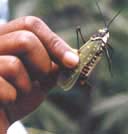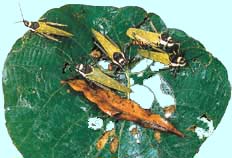 |
 27th September 1998 |
Front Page| |

This could be another swarmBy Chamintha ThilakarathnaKurunegala, barely recov- ered from Cholera, is now threatened by another problem which authorities fear could be every bit as disastrous. This time the threat is not to man, but to the flora and comes in the form of "Avulachis Miliyaris", or in simple terms, the yellow spotted locust. "This could turn out to be the worst of all threats that plantations have faced, if it is not controlled," said Ariyadasa Bandara Abeysinghe, Deputy Plant Control Director of the North Western Province Agricultural Department. Even small gardens have not been spared by the one and a half inch insect, he points out. The locust was first found over a hundred years ago but has begun to multiply alarmingly within the last few years. Surviving solely on greens, it attacks all plants without discrimination. In some estates and gardens in the Kurunegala district one could see that a number of trees had been badly affected. Plantain, coconut and pepper leaves were seen in shreds, all victims of the innocuous looking pest.
The insect has been in existence in Sri Lanka since 1898 but was not hitherto seen as a threat. But changing conditions have brought about a gradual increase over the years. "These unusual weather conditions and climatic changes have provided a good base for these insects to breed," said Mr. Abeysinghe. So far areas such as Kandy, Matale, and even Negombo, Galle, Matara and Moneragala have been under attack adding to the difficulties authorities are already faced with in controlling this menace. Most villagers are not aware of the danger before them. Travelling with the Agriculture Department officials, we met several villagers who were amazed when the Department officials informed them that their gardens are flooded with the green insect. All that one could see is that the leaves of the trees are eaten and only the skeleton of the leaf remains. "If one ignores the problem, at this point, it will not be easy getting rid of the insect," said Mr. Bandara. The risk lies not only in allowing them to exist but also in destroying them, he says. "The only option is to kill the insects. One has to kill them before they reach the breeding stage by either burning their nests or by using insecticides. But insecticide specified for this purpose could be hazardous to the people in the area leaving fire as the only option," he said. According to him, a helicopter could be used to spray the necessary chemical but this would be a large operation requiring all residents to be evacuated at least for a month. At the same time, if one does not control the insect at the least at the egg stage, it will be difficult to destroy the insect later when it is capable of flying about and spreading itself to other provinces. Agricultural authorities warn citizens to inform them immediately if they find the insect in their gardens. Avulachis Miliyaris has not been able to spread itself around the island as yet and that has to be avoided somehow, stress officials. Deputy Director of Research at the Horticultural Institute, in Kandy Dr. C.Kudagamage said that over the hundred years since the discovery of this insect, it had emerged usually once in five years but has now begun to breed every year as seen this year and the last. "Then, it was naturally controlled by predators that existed in forests. But with the depletion of forests for crop land and the reduction of their predators the locust has managed to enter into open lands without much control. It could pose a great threat to crops if it is not controlled," he said. |
||
 |
More Plus * Battle for power
Front Page| News/Comment| Editorial/Opinion| Business| Sports | Mirror Magazine |
|
 |
Please send your comments and suggestions on this web site to |
|
 "They
eat everything that is green. That is the danger of this species. If they
had a preference then they could have been successfully eliminated,"
said Mr. Abeysinghe. The female insect lays around 108 eggs and once the
eggs are laid, it dies.
"They
eat everything that is green. That is the danger of this species. If they
had a preference then they could have been successfully eliminated,"
said Mr. Abeysinghe. The female insect lays around 108 eggs and once the
eggs are laid, it dies.